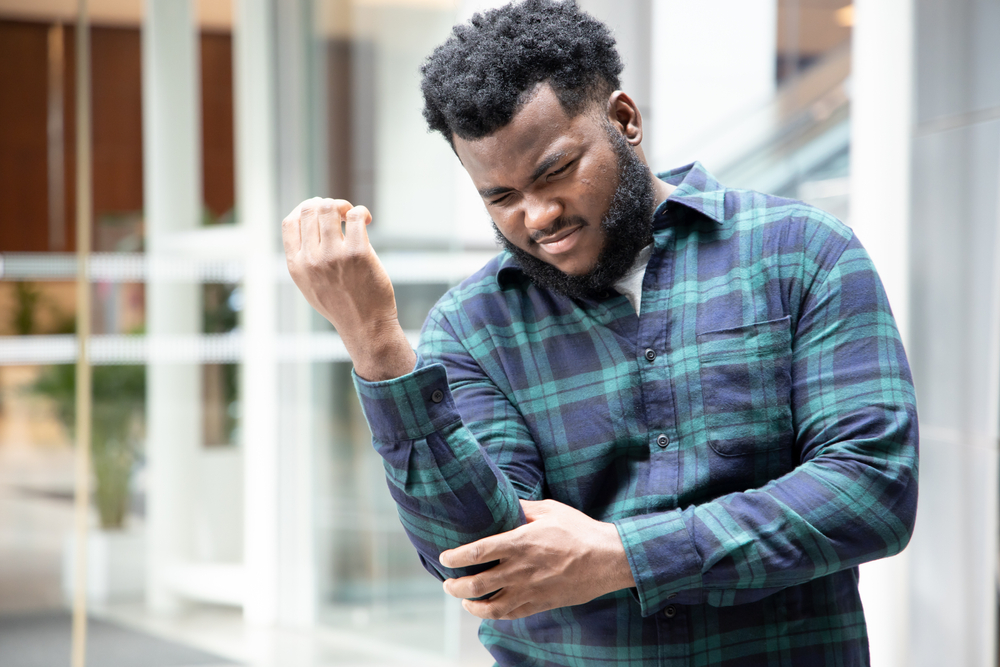
Arthritis vs. Bursitis
Your joints are very complex, anatomical structures. As such, when you begin experiencing joint pain, it is not always easy to determine what the cause. Among the most common health conditions that can cause joint pain are bursitis and arthritis, and because they present with similar symptoms, it can be difficult to differentiate between the two without the help of a medical professional.
The primary difference between arthritis and bursitis is that arthritis affects bone and cartilage of the joints, while bursitis involves inflammation of the bursae, which are sacs filled with lubricating fluid meant to lower friction between tissues. Another important difference is that arthritis is a chronic condition that worsens over time, whereas bursitis normally clears up over a few weeks.
The Structure of Joints
The structure that occurs where two or more bones meet is a joint. Joints are normally complicated structures that must perform a variety of functions, including supporting weight and facilitating range of motion. Many kinds of tissue can be found in various joints:
- Bones—these rigid organs are made from a collagen framework that is imbued with calcium phosphate. In addition to forming the skeleton that gives our bodies shape, bones provide a variety of other functions, including the manufacturing of blood.
- Cartilage—this hard and smooth tissue lines the ends of bones that meet in the joint. This cartilaginous covering prevents bones from grinding against each other.
- Ligaments—these tough, elastic bands of tissue connect bones to one another, and help guide movement within the joint.
- Synovial membrane—the synovial membrane lines the joint and secretes synovial fluid, which lubricates joint for movement.
- Tendons—these tough tissues attach muscles to bones.
- Bursae—these are fluid-filled sacs found between bones, ligaments, and other tissue in joints. Bursae limit joint damage caused by friction and impacts.
What Is Arthritis?
Arthritis is a family of health conditions that usually present with swelling, stiffness, and pain in joints. Among the most common forms of arthritis is osteoarthritis, which is caused by the deterioration of cartilage in joints, and rheumatoid arthritis, which is an auto-immune disorder in which the immune system attacks joint tissue.
If you suspect that you have arthritis, it is vital that you seek medical attention as soon as possible. Arthritis worsens over time, so you should get diagnosed early so that you can immediately begin treatment. Although there is no cure for most forms of arthritis, with the right medical treatments, you can manage symptoms and slow the progression of the disease.
Without proper treatment, arthritis sufferers can experience joint degradation, which can lead to loss of joint function, increased pain, joint deformation, and disability. Treatments vary depending on the type of arthritis, but they may include medications, physical therapy, injections, and lifestyle changes. There are also products that your doctor might inject into the arthritic joint to provide lubrication to minimize inflammation. In addition, there are cutting edge therapies such as stem cells that have shown promising results in cartilage regeneration.
What Is Bursitis?
When the fluid-filled sacs around your joints called bursae become inflamed, bursitis is the result. Bursitis most commonly occurs in the shoulder, hip, or elbow—joints that are frequently involved in repetitive motions. The most common symptoms of bursitis include joint pain, stiffness, swelling, and tenderness; because these symptoms are also common to arthritis, bursitis is often mistaken for arthritis.
There is one telling difference between bursitis and arthritis, however. Because bursitis is often caused by irritation of bursae, usually by repetitive motions, rest will typically relieve symptoms over a couple of weeks. Arthritis, on the other hand, is a progressive disease and will not respond to cessation of activity.
Common risk factors for bursitis include:
- Aging
- Chronic health condition
- Repetitive sports activity
- Poor posture
- Injury to bursae
- Infection that spreads to joint tissue
Although bursitis is not normally a chronic condition, it can become one if left untreated, or if the repetitive motion that is causing it continues. Common examples of bursitis are subacromial bursitis of the shoulder and greater trochanteric bursitis of the hip.
The Differences between Arthritis and Bursitis
To most people, arthritis and bursitis are indistinguishable from one another, at least, in the initial stages. Both conditions have similar symptoms which include pain in the joint areas, stiffness, swelling, and redness. Arthritis and bursitis may appear in and around the wrists, shoulders, knees, and hips; bursitis is more likely to appear in and around the larger joints, while some forms of arthritis first appear in smaller joints like fingers or toes. There are some key distinctions between the two conditions, including:
- Mechanism—while arthritis attacks the principal joint tissue like the cartilage, bursitis affects only the bursae.
- Onset—arthritis tends to appear gradually and progressively worsens, but bursitis may appear suddenly after an injury or intense period of activity.
- Duration—bursitis is an acute condition that typically resolves on its own after a few weeks of rest, while arthritis will worsen over time if not properly managed.
Diagnosing Your Joint Pain
If you are experiencing pain in your joints, it is important to see a doctor as soon as possible to rule out red flags. It may turn out to be bursitis which can be treated with targeted therapies or rest, but it is imperative to rule out much more serious conditions like rheumatoid arthritis or cancer.
When you first visit your doctor, a comprehensive history and physical is the first step. A detailed history may include medical history information about family members (and if they have any chronic health conditions like arthritis), your work and/or exercise routines, and the circumstances related to the pain experience. You may be asked to do some exercises that evaluate your range of motion and pain symptoms.
If the physical exam is not conclusive, then your physician may order additional tests. If your physician suspects an auto-immune condition like rheumatoid arthritis, a full work up, such as blood test and medication trials, may be required. An ultrasonogram or simple injection may be ordered to confirm inflammation of the bursae. If your doctor believes that it is arthritis, then an x-ray or MRI may be ordered to confirm the diagnosis.
If it is bursitis, then your doctor will probably recommend resting the joint, unless the condition is caused by other conditions such as diabetes, gout, or infection. If your joint pain is related to arthritis, then your doctor will work with you to develop a multimodal treatment plan that may include medications, lifestyle changes, injections, and physical therapy.
Article written by: Dr. Robert Moghim – CEO/Founder Colorado Pain Care
M.D. Disclaimer: The views expressed in this article are the personal views of Robert Moghim, M.D. and do not necessarily represent and are not intended to represent the views of the company or its employees. The information contained in this article does not constitute medical advice, nor does reading or accessing this information create a patient-provider relationship. Comments that you post will be shared with all visitors to this page. The comment feature is not governed by HIPAA and you should not post any of your private health information.



